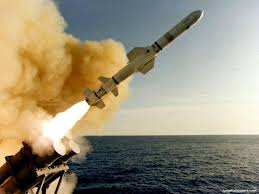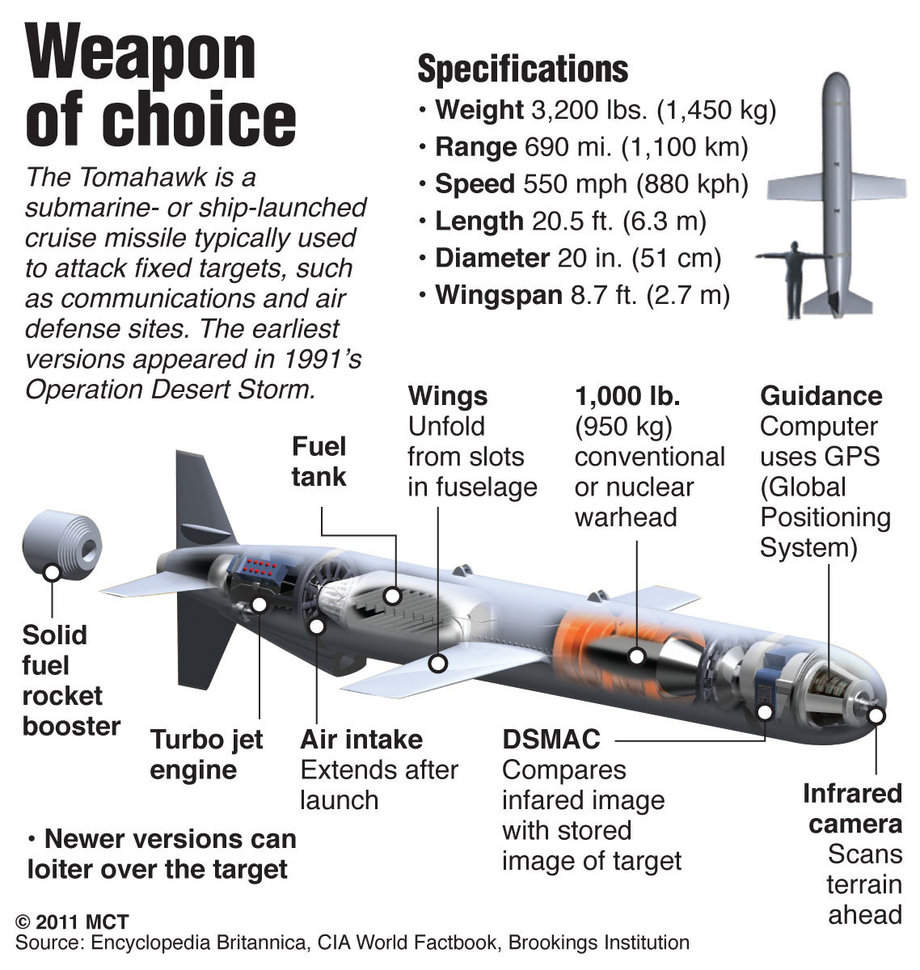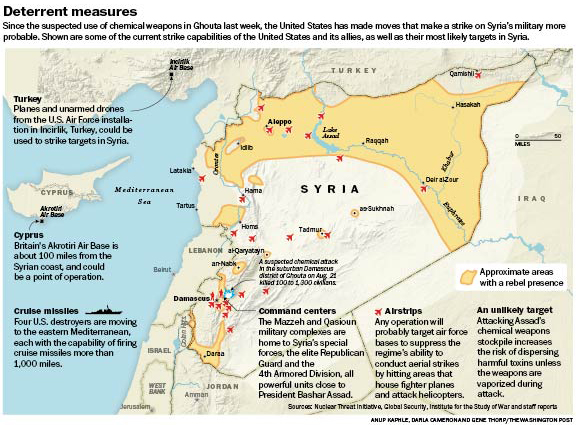 If President Obama orders the strike on Syria that Congress is considering, the U.S. Navy will be at the forefront of a cruise missile attack that has the unusual objective of degrading Syria’s chemical weapons capabilities without striking at the heart of the program.
If President Obama orders the strike on Syria that Congress is considering, the U.S. Navy will be at the forefront of a cruise missile attack that has the unusual objective of degrading Syria’s chemical weapons capabilities without striking at the heart of the program.
The mission is among the most complex the U.S. military has launched in recent history because Syria will have had weeks to shield its most vulnerable targets from a widely anticipated volley of Tomahawk missiles launched from four Navy destroyers stationed in the eastern Mediterranean.
As lawmakers continue to discuss the scope and risks of a strike, military planners are fine-tuning a plan to blast dozens of targets that include air defense infrastructure, long-range missiles, rocket depots and airfields, according to defense officials and military analysts. With roughly three dozen Tomahawk missiles loaded onto each of the four destroyers, a U.S. strike could inflict significant damage on government forces, which remain capable, albeit weakened, after a 21 / 2-year-old conflict that has killed more than 100,000 people.
The Pentagon says the goal of the operation is to dissuade Syrian President Bashar al-Assad from using chemical weapons, following an alleged sarin attack last monththat U.S. officials say was carried out by the regime and killed more than 1,400 people.
The administration is not contemplating blasting suspected chemical weapons sites because doing so could unleash deadly chemicals into densely populated areas. While regime change is not the goal of the operation, U.S. officials recognize that if the strikes are successful, they could pave the way for rebel advances. But they are billing them as mainly a punitive measure.
“If I were in the Syrian military right now, facing the prospects of U.S. military action. . . I think it would make me think twice about using chemical weapons again,” Pentagon spokesman George Little told reporters this week.
 The six air bases the Syrian government is currently using to carry out the bulk of its military operations and its roughly two dozen stationary radars are likely targets of cruise missile strikes, according to military analysts who have studied Syria’s armed forces. Military and intelligence headquarters could also be struck if the risk of civilian casualties is deemed low.
The six air bases the Syrian government is currently using to carry out the bulk of its military operations and its roughly two dozen stationary radars are likely targets of cruise missile strikes, according to military analysts who have studied Syria’s armed forces. Military and intelligence headquarters could also be struck if the risk of civilian casualties is deemed low.
Gen. Martin Dempsey, the chairman of the Joint Chiefs of Staff, told lawmakers last weekthat the strikes would likely hit Syrian long-range missile and rocket depots because the weapons can be used to protect — and deliver — chemical weapons.
Dempsey said the Assad regime has begun taking steps to shield its most vulnerable targets, in some instances moving prisoners to would-be targets. “Our intelligence is keeping up with that movement,” Dempsey said.
The advance warning poses significant challenges for military planners. But it is also degrading the Syrian military’s capabilities because Assad is likely dispersing troops and equipment, said former Navy planner Christopher Harmer, an analyst at the Institute for the Study of War who has been studying the Syrian unrest.
“The easiest defensive measure you can take is putting humans around targets, especially when there’s such a debate about whether you’re going to do this or not,” he said. “The downside for Assad is that when he disperses forces, it’s more difficult to attack the rebels.”
The Obama administration has said it does not intend to deploy ground troops to Syria and does not appear inclined to use bombers. That has left the burden of the operation squarely on the Navy, which played a support role in the Iraq and Afghanistan wars.
The Navy has kept four Arleigh Burke-class guided missile destroyers stationed within firing range of the Syrian coast for several days. The ships — the USS Ramage, USS Barry, USS Gravely and USS Stout — are loaded with the latest generation of Tomahawk missiles.
Tomahawks, which made their debut during the Persian Gulf War in 1991, have been used in several military campaigns, often as the first salvos of protracted engagements. They were used during the early days of the Iraq and Afghanistan wars and most recently to pave the way for the establishment of a no-fly zone over Libya in 2011. Raytheon, the defense giant that manufactures the missiles, has marketed them as an alternative todrones, which have become the weapon of choice in U.S. stealth counterterrorism attacks.
“Unmanned aircraft seem to get all the headlines these days,” the company’s promotional Web site for Tomahawks says. “But the ship and submarine-launched Tomahawk cruise missile — an unmanned aircraft that goes on a one-way trip — is quietly upping its game.”
Unlike earlier versions, today’s Tomahawks, which cost roughly $1.5 million apiece, can be programmed quickly using GPS technology to strike targets and may be redirected midflight. The missile, which has a 1,000-mile range, can be airborne for up to four hours and deliver a 1,000 pound bomb or a package of 166 “bomblets.” The first would be ideal for a crushing blow to a critical building, while the latter would be effective against a wider area, such as a parking lot with military vehicles or a warehouse that contains weapons.
The Washington Post

Leave a Reply
You must be logged in to post a comment.